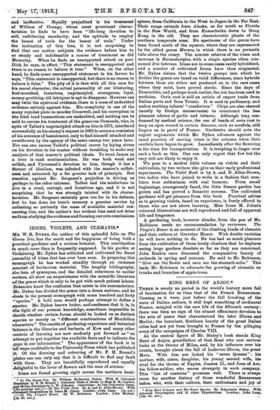KING RENE OF ANJOU.* THERE is surely no period in
the world's history more full of fascination for us than that of the French Renascence. Coming, as it were, just before the full breaking of the wave of Italian culture, it still kept something of mediaeval France, mingled with the new life of the fifteenth century: there was then no sign of the almost effeminate devotion to the arts of peace that characterized the later Sforza and Medici; the luxuriant, Southern beauty of the great Italian cities had not yet been brought to France by the pillaging army of the campaigns of Charles VIII.
As the central figure of Mr. Staley's book stands King Rene of Anjou, grandfather of that Rene who cast envious looks at the throne of Milan, and, by his influence over his cousin, brought about the fall of Lodovico Sforza, the great Moro. With him are linked his "seven Queens " : his mother, wife, sister, daughter, his young second wife, his rival for the throne of Naples, Joanna II., and Joan of Arc, his fellow-soldier, who moves strangely in such company. This "list of contents" promises well. There is always room for another history of those wonderful Renascence ladies, who, with their culture, their enthusiasm and joy of • King Beni &Anjou and His Seven Queens. By Edgcumbe Staley. With coloured Frontispiece and 35 other Illustrations. London John Long. [126. 6d. net.] life, their rough horse-play and admirable dignity, drew together to their courts, as did the Medici and d'Estes in Italy, all that was best in work, and art, and love. Mr. Staley has, however, proved himself somewhat incapable of dealing with this vast amount of material. He starts off badly : in the preface, concerning his "seven Queens ": "I have immense pleasure," he says, "in introducing them to any clientele"; he then names only six. Again, one at least of his quotations from King Rene is wrongly translated, and though his " bibliography " is large and much of his account rich in detail, he fails throughout to convince us of the reality of his "queens," and is lacking in that intimacy without which a history can never be more than a collection of names and dates. It seems, moreover, a pity that Mr. Staley was so unfortunate in his choice of an indexer for his book. Such entries as " Lioness at bay, like a," " Oh fie, oh fie! " "Peach, slipped on a," are surely not intended for serious publication.
It is a relief and a happiness to turn from this inadequacy to the altogether delightful reproductions of contemporary miniatures and portraits, many of them Rene's own work, which, with their straight simplicity and vivid insight, do bring to us, in spite of all, something of the spirit of the French Renascence.











































 Previous page
Previous page